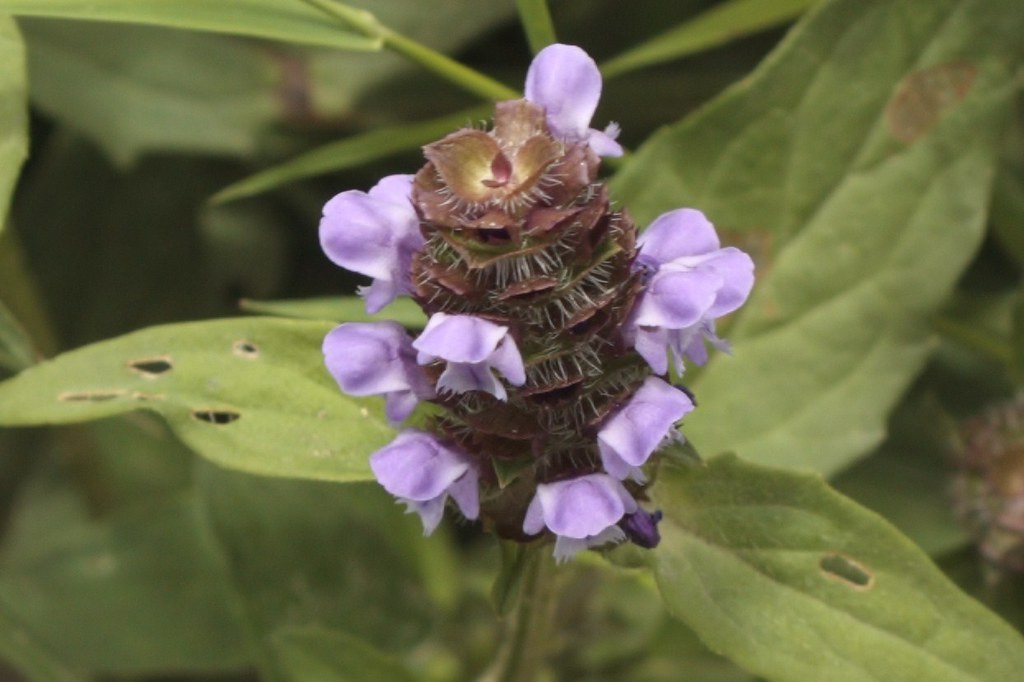 |
| Heal-all, also called self-heal |
 |
| After the blossoms have gone by, the plant appears like this. |
 |
| A view from the top of a flower. |
Heal-all is a fascinating flower. It grows wild almost everywhere and is very common here in northern Vermont. You could even call it a native invasive, so if you plant it, be careful! But if you have no fear of natural herb remedies, it can be a useful plant to invade you. The following paragraphs are from
Alternative Nature Online Herbal at
http://www.altnature.com/gallery/healall.htm. I do
not advocate the use of this plant for medicine, but I am publishing it out of my interest in gathering folk wisdom:
Properties
Heal-All is edible and medicinal, can be used in salads, soups, stews, or boiled as a pot herb. Used as an alternative medicine for centuries on just about every continent in the world, and for just about every ailment known to man, Heal-All is something of a panacea, it does seem to have some medicinal uses that are constant. The plants most useful constituents are Betulinic-acid, D-Camphor, Delphinidin, Hyperoside, Manganese, Oleanolic-acid, Rosmarinic-acid, Rutin, Ursolic-acid, and Tannins. The whole plant is medicinal as alterative, antibacterial, antipyretic, antiseptic, antispasmodic, astringent, carminative, diuretic, febrifuge, hypotensive, stomachic, styptic, tonic, vermifuge and vulnerary. A cold water infusion of the freshly chopped or dried and powdered leaves is a very tasty and refreshing beverage, weak infusion of the plant is an excellent medicinal eye wash for sties and pinkeye. It is taken internally as a medicinal tea in the treatment of fevers, diarrhoea, sore mouth and throat, internal bleeding, and weaknesses of the liver and heart. Clinical analysis shows it to have an antibacterial action, inhibiting the growth of pseudomonas, Bacillus typhi, E. coli, Mycobacterium tuberculi, which supports its use as an alternative medicine internally and externally as an antibiotic and for hard to heal wounds and diseases. It is showing promise in research for cancer, AIDS, diabetes, and many other maladies.
Folklore
Once proclaimed to be a Holy herb and thought to be sent by God to cure all ailments of man or beast, and said to drive away the devil, which lead to the belief that Heal-All was grown in the Witches garden as a disguise. The root was used to make a tea to drink in ceremonies before going hunting by one Native American tribe to sharpened the powers of observation.
Recipe
Medicinal tea or infusion: Add 1 oz. dried or fresh herb to a pint of boiling water, steep till cool, take in ½ cup doses, sweetened with honey, as a general strengthener.
Article by Deb Jackson & Karen Bergeron
I thank you for visiting this week! I look forward to viewing all of your beautiful photographs.
_/\_/\_




This medicinal flower is very pretty and sounds like it packs a big punch! I think most flowers/herbs have some qualities for medicinal use, its just knowing those qualities and how to use them responsibly.
ReplyDeleteVery interesting photo and informative posting. Thanks for sharing.
ReplyDeleteThis is a very interesting post! I've never seen this plant before (I live in California), but it sounds like it does have some medicinal qualities. Great post today.
ReplyDeleteMy TF is here:
http://www.patandjerry.com/2010/09/labor-day-corn-roast-and-family.html
Gorgeous shots, Andree! You've got it all up there.
ReplyDeleteAmazing... it looks like a face in the last shot!! L
ReplyDeleteInteresting form on this plant. I've never heard of it, thanks for the lesson.
ReplyDeleteSuch a fascinating, beautiful plant with quite a story attached! Loved this post!
ReplyDelete